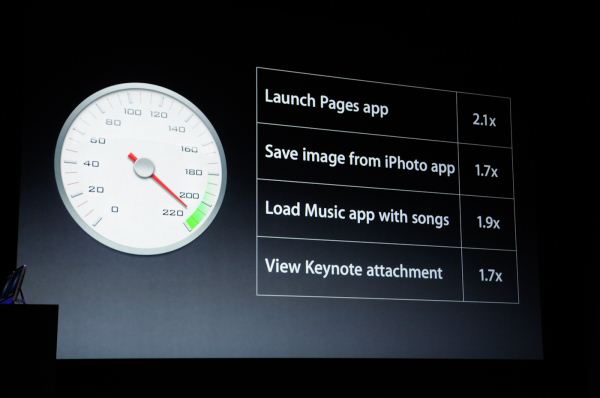Apple's iPhone 5 Uses A6 SoC
by Anand Lal Shimpi on September 12, 2012 1:27 PM EST- Posted in
- Smartphones
- Apple
- Mobile
- iPhone 5
This one caught us off guard, but Apple just announced the A6 SoC powering the new iPhone 5 features 2x faster CPU and GPU performance compared to the iPhone 4S. Apple reserves major Ax SoC number iterations for architecture changes, combine that with the performance claims as well as some other stuff we've heard offline and there's one conclusion: the iPhone 5 uses ARM Cortex A15 cores inside. Update: It uses a custom Apple core!
Our guess is two cores. No word on the GPU yet.
The A6 is 22% smaller than the A5, although it's not clear if that's a package or die size claim yet. There's a good chance this is built on Samsung's 32nm LP HK+MG process.











118 Comments
View All Comments
ufon68 - Wednesday, September 12, 2012 - link
To reach the 2x speed increase, the frequency would have to go substantially higher than it currently is, which would probably cause higher power consumption, or about the same at best , even when considering die shrink due to smaller manufacturing process. It doesn't add up.ufon68 - Wednesday, September 12, 2012 - link
Simply put, i don't think you can increase the speed 2x and lower the power consumption at the same time through die-shrink alone.tipoo - Wednesday, September 12, 2012 - link
The 32nm A5 in the shipping iPad 2 consumes a significantly lower amount of power. And the extra cores would be power gated.Lucian Armasu - Wednesday, September 12, 2012 - link
It's not like it would be the first time Apple overhyped something. Remember when they were saying A5's graphics was 9x times bigger than Tegra 2. Sure, that was true in some very specific and light tests, but overall it was only like 2x better or something.The "2x increase in performance" claim could come from being a quad core, too. That's how Nvidia markets its Tegra 3, too, pretty much. Don't read too much into it.
Exophase - Wednesday, September 12, 2012 - link
They said it was 9x faster than A4 (SGX535) which was a fairly valid assessment. They didn't say anything about Tegra 2.The 2x claims are backed up by at least some software figures so I don't think they're just playing fake marketing numbers on this one. That doesn't rule out quad core though, I could easily see both quad core and higher clocks.
1008anan - Wednesday, September 12, 2012 - link
Brain and Anand, what do we know about A6 specs?--can we confirm that they are all fabricated at 28 nm by Samsung?
--I think we can confirm that there are two A-15 Cortex cores?
--Is there a lower performance low power companion core that performs functions while the two A-15 cores are in sleep mode? [Similar to the two M-4 Cortex cores in the OMAP 5]
--What do we know about graphics (are the rumors of rogue correct)?
--single precision gigaflops?
--triangles per second?
--max wattage TDP?
--idle power wattage?
--maximum megapixel frontside and backside camera supported by SoC?
--LTE baseband wattage TDP?
--wi-fi wattage TDP? (Brian, woo-hoo, real wi-fi at last!!!)
--other SoC performance metrics?
Apple has matched TXN as one of the first two venders to bring A-15 Cortex to market. However, Apple is the first to introduce A-15 in huge volume. More than 30 million before this year is out (maybe more than 40 million). Many millions this month. Amazing.
tipoo - Wednesday, September 12, 2012 - link
Pretty sure it is 32nm, not 28, as they were ramping up 32nm production with the ATV and iPad 2.menting - Wednesday, September 12, 2012 - link
So 2X faster means 3x the speed right?Because if it's not the case, for example, 50% faster will mean half the speed only.
Or are they misleading on purpose?
mavere - Wednesday, September 12, 2012 - link
I think your mathematics got stuck somewhere in elementary school.menting - Wednesday, September 12, 2012 - link
how so?0.1X faster = 1.1X the original speed.
0.5X faster = 1.5X the original speed.
1X faster = 2X the original speed.
2X faster = 3X the original speed.
So I'm just trying to get clarification that when Apple says 2X faster in their slide, they actually mean 3X the original speed, and not just 2X the original speed, which will be "1X faster"